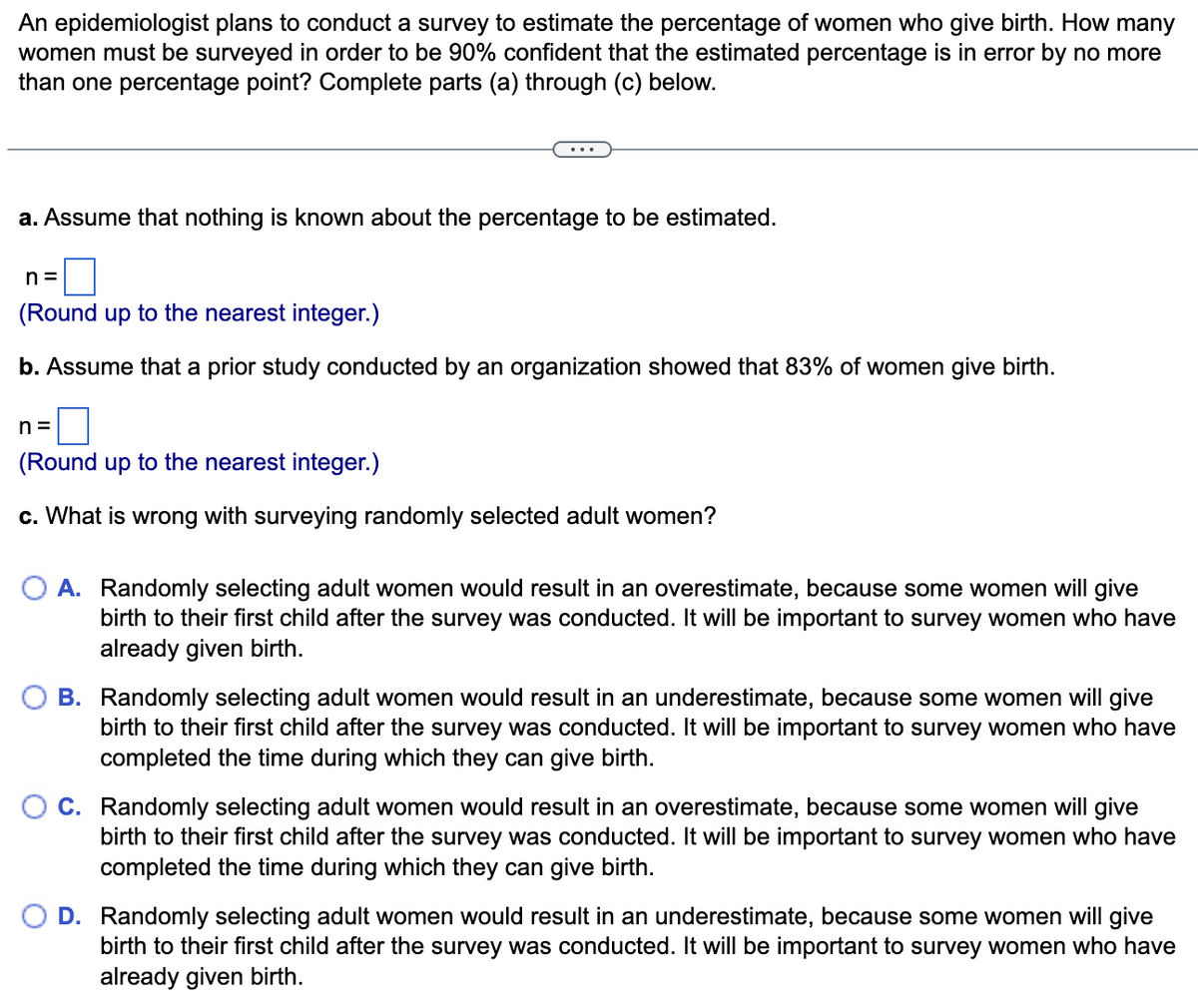An epidemiologist plans to conduct a survey to estimate the percentage of women who give birth. How many women must be surveyed in order to be 90% confident that the estimated percentage is in error by no more than one percentage point? Complete parts (a) through (c) below. ... a. Assume that nothing is known about the percentage to be estimated. n= (Round up to the nearest integer.) b. Assume that a prior study conducted by an organization showed that 83% of women give birth. n= (Round up to the nearest integer.) c. What is wrong with surveying randomly selected adult women? O A. Randomly selecting adult women would result in an overestimate, because some women will give birth to their first child after the survey was conducted. It will be important to survey women who have already given birth. B. Randomly selecting adult women would result in an underestimate, because some women will give birth to their first child after the survey was conducted. It will be important to survey women who have completed the time during which they can give birth. C. Randomly selecting adult women would result in an overestimate, because some women will give birth to their first child after the survey was conducted. It will be important to survey women who have completed the time during which they can give birth. D. Randomly selecting adult women would result in an underestimate, because some women will give birth to their first child after the survey was conducted. It will be important to survey women who have already given birth.
An epidemiologist plans to conduct a survey to estimate the percentage of women who give birth. How many women must be surveyed in order to be 90% confident that the estimated percentage is in error by no more than one percentage point? Complete parts (a) through (c) below. ... a. Assume that nothing is known about the percentage to be estimated. n= (Round up to the nearest integer.) b. Assume that a prior study conducted by an organization showed that 83% of women give birth. n= (Round up to the nearest integer.) c. What is wrong with surveying randomly selected adult women? O A. Randomly selecting adult women would result in an overestimate, because some women will give birth to their first child after the survey was conducted. It will be important to survey women who have already given birth. B. Randomly selecting adult women would result in an underestimate, because some women will give birth to their first child after the survey was conducted. It will be important to survey women who have completed the time during which they can give birth. C. Randomly selecting adult women would result in an overestimate, because some women will give birth to their first child after the survey was conducted. It will be important to survey women who have completed the time during which they can give birth. D. Randomly selecting adult women would result in an underestimate, because some women will give birth to their first child after the survey was conducted. It will be important to survey women who have already given birth.
Holt Mcdougal Larson Pre-algebra: Student Edition 2012
1st Edition
ISBN:9780547587776
Author:HOLT MCDOUGAL
Publisher:HOLT MCDOUGAL
Chapter11: Data Analysis And Probability
Section11.4: Collecting Data
Problem 1E
Related questions
Question

Transcribed Image Text:An epidemiologist plans to conduct a survey to estimate the percentage of women who give birth. How many
women must be surveyed in order to be 90% confident that the estimated percentage is in error by no more
than one percentage point? Complete parts (a) through (c) below.
a. Assume that nothing is known about the percentage to be estimated.
n=
(Round up to the nearest integer.)
b. Assume that a prior study conducted by an organization showed that 83% of women give birth.
n=
(Round up to the nearest integer.)
c. What is wrong with surveying randomly selected adult women?
O A. Randomly selecting adult women would result in an overestimate, because some women will give
birth to their first child after the survey was conducted. It will be important to survey women who have
already given birth.
B. Randomly selecting adult women would result in an underestimate, because some women will give
birth to their first child after the survey was conducted. It will be important to survey women who have
completed the time during which they can give birth.
C. Randomly selecting adult women would result in an overestimate, because some women will give
birth to their first child after the survey was conducted. It will be important to survey women who have
completed the time during which they can give birth.
D. Randomly selecting adult women would result in an underestimate, because some women will give
birth to their first child after the survey was conducted. It will be important to survey women who have
already given birth.
Expert Solution
This question has been solved!
Explore an expertly crafted, step-by-step solution for a thorough understanding of key concepts.
This is a popular solution!
Trending now
This is a popular solution!
Step by step
Solved in 3 steps with 2 images

Recommended textbooks for you

Holt Mcdougal Larson Pre-algebra: Student Edition…
Algebra
ISBN:
9780547587776
Author:
HOLT MCDOUGAL
Publisher:
HOLT MCDOUGAL

College Algebra (MindTap Course List)
Algebra
ISBN:
9781305652231
Author:
R. David Gustafson, Jeff Hughes
Publisher:
Cengage Learning

Holt Mcdougal Larson Pre-algebra: Student Edition…
Algebra
ISBN:
9780547587776
Author:
HOLT MCDOUGAL
Publisher:
HOLT MCDOUGAL

College Algebra (MindTap Course List)
Algebra
ISBN:
9781305652231
Author:
R. David Gustafson, Jeff Hughes
Publisher:
Cengage Learning